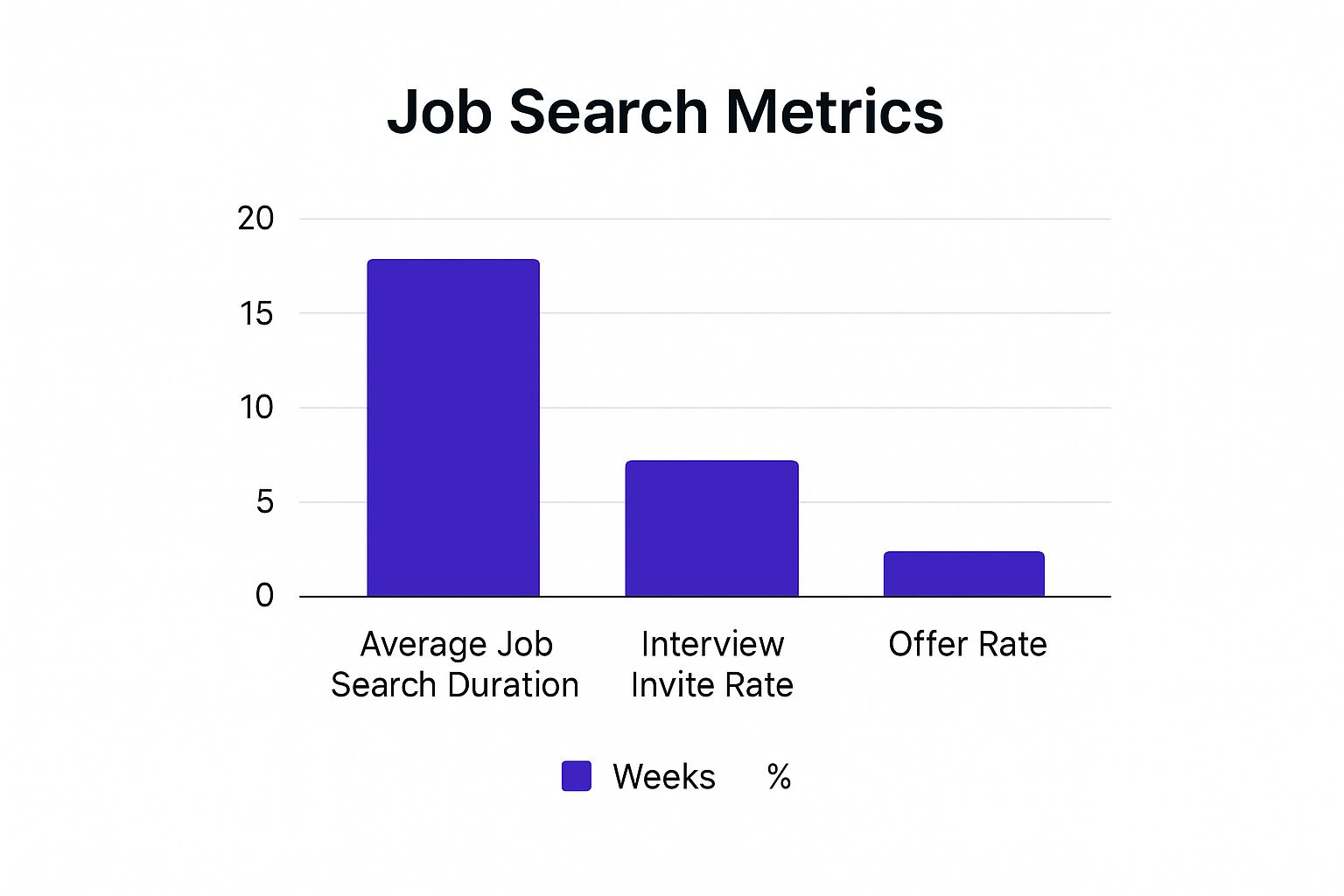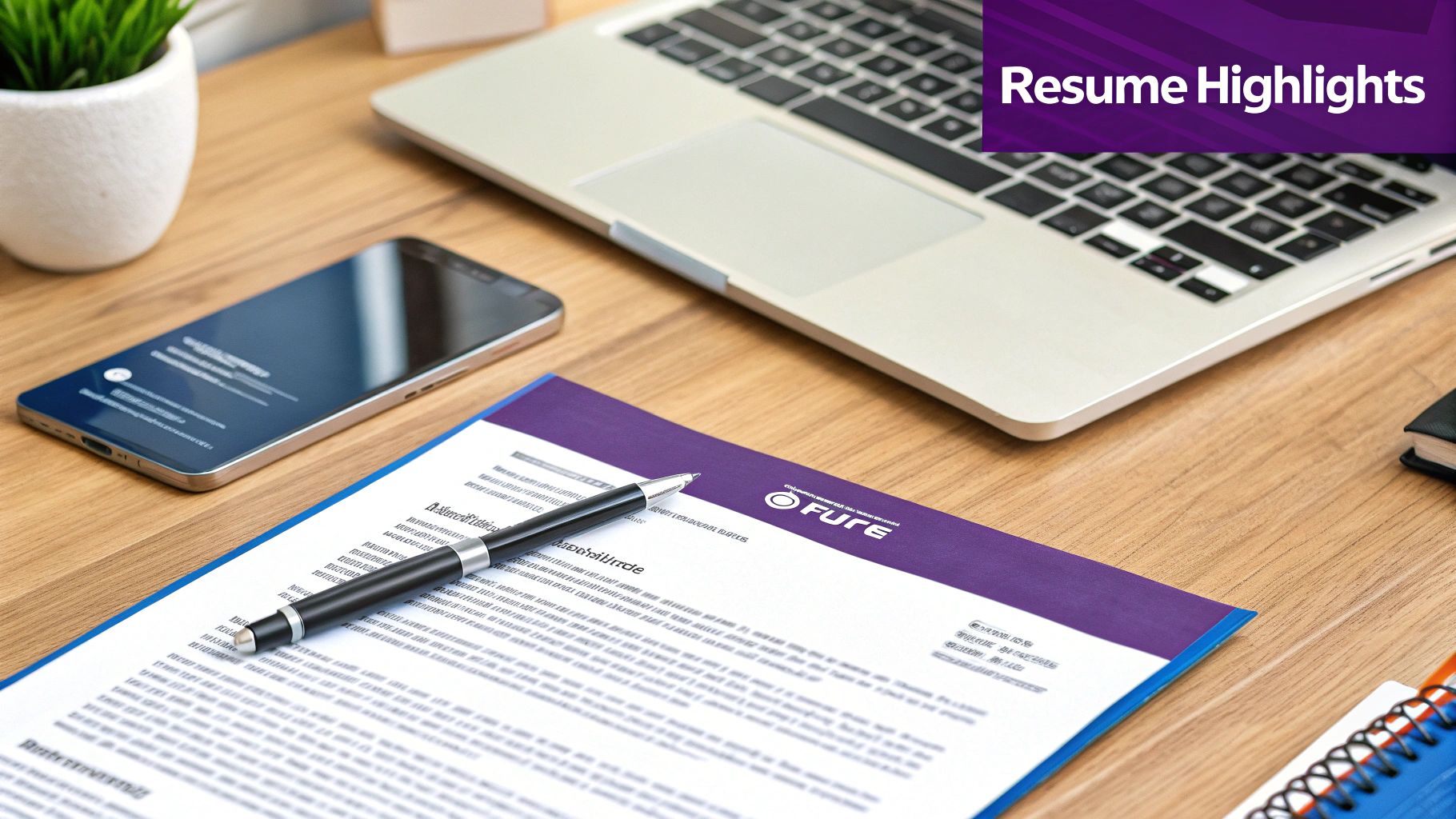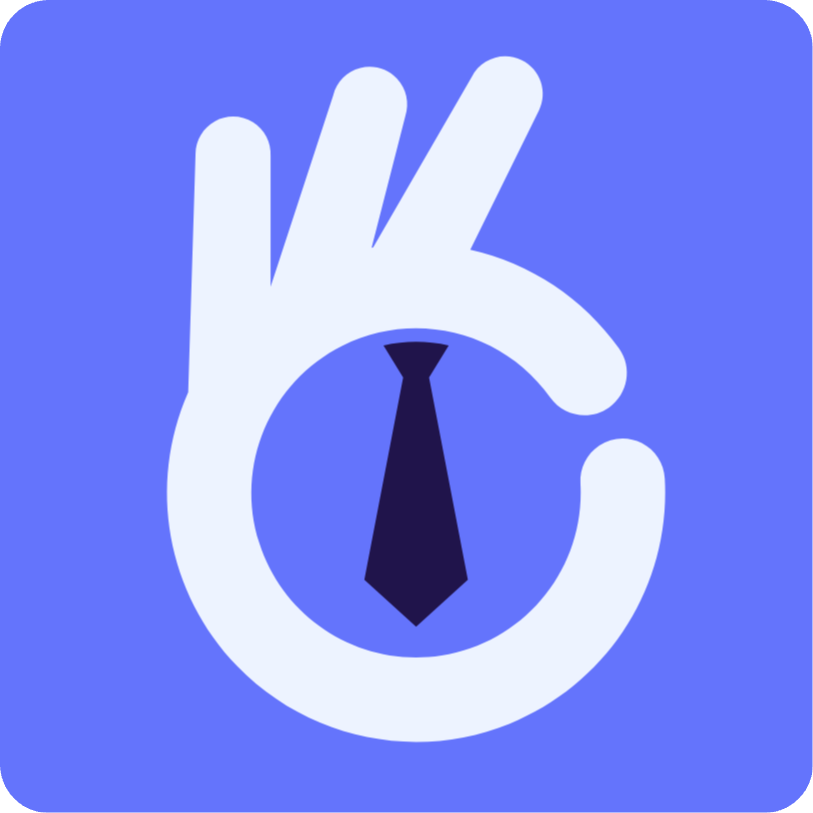How to Get Hired Faster: Expert Tips to Speed Up Your Job Search
What Hiring Managers Really Want (And How to Give It to Them)
If you feel like the job market has completely shifted gears, you’re on the right track. The days of endless interview rounds and painfully slow hiring processes are fading. Today, speed and decisiveness are what get deals done. So, figuring out how to get hired faster isn’t just about tweaking your resume; it’s about understanding the real motivations driving hiring managers.
I've had candid conversations with dozens of hiring managers, and a consistent theme always pops up: they're looking for the path of least resistance to a great hire. This means they gravitate toward candidates who make their value clear from the start, making the decision to move forward feel like a no-brainer. A candidate who can solve their problem right now is often far more appealing than a "perfect" candidate who might show up weeks down the line.
Decoding Their Top Priorities
When a hiring manager glances at your application, they're running a mental checklist that goes beyond the basic job requirements. They're searching for signals that you are not just qualified, but a low-risk, high-reward choice who can get up to speed quickly.
Here’s what they’re really looking for:
- Problem Solvers, Not Just Skill-Set Holders: Can you connect your past accomplishments to their company's current struggles? They want to see you’ve done your homework and can clearly state how you are the solution.
- Clarity and Confidence: A confusing resume or a hesitant interview answer plants a seed of doubt. A clean, impactful application tells a compelling story and shows you're a professional who communicates with purpose. You can use a tool like the Eztrackr resume builder to help organize your story.
- Enthusiasm and Genuine Interest: A generic, copy-and-paste application is spotted from a mile away. Hiring managers want to see that you're specifically excited about their company and this role, not just any job. This indicates you're more likely to accept an offer and stick around.
This next chart really drives home how a targeted approach stacks up against the average job search.

The numbers don't lie. A more focused strategy doesn't just cut down the time it takes to get an offer—it significantly improves your odds at every single stage of the process.
The Fast-Track Industries and Companies
This need for speed isn't the same everywhere. The global labor market is incredibly competitive, with some forecasts showing the unemployment rate hitting a historic low of 4.9% in early 2025. This pressure forces many companies, especially in high-demand fields like tech and healthcare, to move faster to land top talent before a competitor does.
To help you see where the action is, here’s a look at how hiring speed can differ across various sectors.
Industry Hiring Speed Comparison
Data showing average time-to-hire across different industries and company sizes
| Industry | Average Time to Hire | Technology Adoption Level | Competitive Advantage |
|---|---|---|---|
| Technology/IT | 20-30 days | High | Fast-paced innovation requires rapid talent acquisition. |
| Healthcare | 30-45 days | Medium-High | High demand for specialized roles; speed is crucial to fill critical positions. |
| Finance & Banking | 40-55 days | High | Rigorous background checks can extend timelines, but tech adoption is accelerating it. |
| Manufacturing | 35-50 days | Medium | Varies by role; technical positions fill faster than management. |
| Government/Public Sector | 60-90+ days | Low | Bureaucratic processes and multiple approval layers significantly slow hiring. |
The key takeaway here is that industries with high competition and a strong reliance on modern technology are generally quicker to hire. They simply can't afford to wait. You can explore the full jobs report for a deeper dive into these market trends.
Ultimately, giving hiring managers exactly what they want—a clear, confident, and enthusiastic solution to their problems—is your most direct path to a faster job offer.
Cracking the ATS Code Without Sounding Like a Robot

Let’s be honest: the idea that your polished resume might get rejected by a machine before a person even sees it is a major headache. With up to 75% of resumes getting filtered out by an Applicant Tracking System (ATS), it's a real concern for any job seeker. The common advice is to cram your resume with keywords, but that often creates a clunky, robotic document that a hiring manager will immediately dislike. The true key to landing a job faster is writing a resume that appeals to both the software and the human reviewer.
This balancing act isn't as tricky as it seems. It all starts with understanding what the ATS is really looking for: relevance. The system scans your resume for keywords and phrases from the job description to see how well you match the position. It’s not about keyword density; it’s about genuine alignment. This means you need to thoughtfully include the exact terms from the job post while keeping your writing natural and focused on your achievements.
Optimizing for Both Robots and Recruiters
Your goal is to create one document that is simple for software to read and persuasive for a person to review. Think of it as giving both audiences a clear map to your qualifications. To make sure your application makes it past the first hurdle, getting a handle on how to properly format an ATS-friendly resume is essential.
Here are a few practical tips to get it right:
- Mirror Key Phrases: If the job listing mentions "client relationship management," use that exact phrase. Don't substitute it with something similar like "customer care" or "account handling."
- Use Standard Section Headers: Stick to familiar titles like "Work Experience," "Education," and "Skills." Creative headers such as "My Journey" or "Where I've Been" can confuse the software.
- Avoid Complex Formatting: Steer clear of tables, columns, and fancy elements in your header or footer. These can trip up older ATS programs, causing them to misread or even ignore your information. A clean, single-column layout is your safest bet.
From Keywords to Callbacks
Optimizing your resume is more than just a defensive strategy; it's a direct path to getting more responses. Recent data shows that resumes tailored for these systems can see callback rates increase by about 25%. When you combine this approach with highlighting in-demand skills like data analysis or AI familiarity, your application stands out even more. You can explore more about these job search trends on Huntr.co. This same optimization principle applies to your cover letter, where a tool like a job cover letter generator can help you quickly build a tailored, keyword-rich document that perfectly supports your resume.
Why Remote Opportunities Are Your Fast Track to Employment

If you want to know how to get hired faster, consider this: aiming for remote jobs could be your smartest strategy. The way we work has changed for good, and companies that hire remotely are often set up for speed. They don't have to deal with the logistics of in-person interviews, office tours, or aligning schedules across different cities. This change alone can shave days, or even weeks, off a standard hiring process.
Decision-makers in remote-first companies are used to making quick, solid choices through virtual calls. Just think about it—a hiring manager can hold three video interviews in the time it would take to bring one candidate into the office. This efficiency helps them move good candidates along much faster. When a company's whole operation is digital, its recruitment process tends to be just as quick and flexible. This is a perfect setup for any job seeker ready to act fast.
Positioning Yourself as the Ideal Remote Candidate
To get noticed in a worldwide talent pool, a good resume isn't enough. You have to prove you can do great work without someone looking over your shoulder. Hiring managers are searching for clear signs that you're a self-starter who can jump right in and contribute.
To show you’re built for remote work, be sure to highlight:
- Proactive Communication: When describing your accomplishments, talk about how you took the lead. Did you manage a project with a team spread across different locations? Mention it. Did you set up a new way to keep everyone in the loop? That’s a huge plus.
- Tech Proficiency: Show off your comfort with the tools that make remote work possible. Mentioning your skills with platforms like Slack, Asana, Trello, or Microsoft Teams tells them you won’t need a lot of training to get started.
- Demonstrating Autonomy: Your application should paint a picture of someone who takes charge. Use strong action words that show you own your work, like "managed," "spearheaded," or "independently developed."
The Speed Advantage of Remote-First Companies
The move to remote work is about more than just culture; it’s also about technology. Companies that are fully remote are often the first to adopt new tools, including AI in their recruiting. In fact, studies show that businesses using modern hiring tools can cut their average time-to-hire by an impressive 25-30%.
Job seekers who focus on remote roles often get offers within two weeks—a speed you rarely see in traditional, office-based hiring. You can explore more data on the 2025 global hiring landscape to understand these trends better. By targeting these forward-thinking companies, you aren't just looking for a job; you're plugging into a faster, more effective way of hiring.
Building a Personal Brand That Works While You Sleep
Is your professional reputation working for you around the clock, or is it basically invisible? In a crowded job market, there's really no in-between. A strong personal brand is like your own silent advocate, catching the eye of recruiters and getting you hired faster—sometimes before you even start looking. It’s the difference between constantly chasing down opportunities and having them land right in your inbox.
Think about it from a recruiter's perspective. When they search your name, what story do they find? Is it compelling and professional, or is it a blank slate? A well-built brand elevates you from being just another name on a spreadsheet to a sought-after professional. This means going beyond a simple resume and creating a living, breathing online presence that proves what you can do.
Your Brand’s Most Valuable Assets
Building a powerful personal brand isn't about becoming a big-shot influencer. It's about being strategically visible where it counts. The first place to focus is LinkedIn, since that's where hiring managers live and breathe. Your profile needs to be more than a dry history of your past jobs; treat it like a sales page for your skills. This starts with a headline that immediately tells people your value. If you're stuck, a good LinkedIn headline generator can spark some ideas to help you stand out.
Once your headline is set, focus on these key pieces to build a brand that speeds up your job search:
- A Portfolio That Proves Your Worth: Don't just say you have skills—show them. Put together a simple portfolio website with your best work, interesting case studies, or personal projects. This gives hiring managers solid proof of what you're capable of.
- Consistent, Valuable Content: You don't have to post every single day. Just sharing one insightful article or a thoughtful comment on an industry post once a week shows you're engaged and know your stuff.
- An Optimized LinkedIn Profile: Make sure your profile is packed with keywords from job descriptions you're targeting. Here’s a stat that should get your attention: a complete profile with a professional photo receives 21 times more views and up to 36 times more messages.
For a deeper dive into crafting and promoting your professional identity, check out this ultimate personal branding guide. When you actively manage your online presence, you build a system that constantly works for you, making it much easier for the right people to find you and bring you on board.
Networking That Opens Doors (Not Just Collects Business Cards)

Let's move past the old-school idea of networking—stiff handshakes and a pocket full of business cards. If you want to figure out how to get hired faster, you have to see networking as building genuine relationships, not just racking up contacts. The best roles are often filled by word-of-mouth before they ever hit a job board, and the only way in is through a real connection. A referral from someone the hiring manager trusts can instantly move your resume to the top of the stack.
Think about it this way: applying online is like showing up at the front door with a hundred other people. Having a solid network connection is like getting a personal invitation to come in through a side entrance.
The Art of the Informational Interview
One of the most effective and surprisingly underused networking strategies is the informational interview. This isn't a sneaky way to ask for a job. It’s a brief, focused chat to get an inside look from someone who is already in a company or role you’re interested in. The objective is to learn and gather information, which leaves a much stronger, more positive impression than asking for a handout.
When you reach out, be specific and show that you respect their time. Ditch the vague "Can I pick your brain?" request and try something more direct:
"Hi [Name], I came across your work on [Project/Article] and was really impressed. I'm exploring a career in [Their Field] and would appreciate 15 minutes of your time to learn more about your experience at [Their Company]. I've already applied for the [Role Name] position and would value your perspective."
This message proves you’ve done your research and genuinely value their specific insights.
Making Digital Connections Count
Beyond direct outreach, your everyday online presence can open doors you didn’t know were there. Actively and thoughtfully participating in industry-specific LinkedIn groups or professional forums is a fantastic way to become visible to recruiters and decision-makers.
Here’s how to make it work:
- Ask insightful questions that get people talking.
- Share relevant articles but add your own commentary or takeaway.
- Congratulate people on their wins and promotions to build rapport.
These small, consistent actions position you as a knowledgeable and engaged professional. Over time, these online relationships become a powerful asset. When a new opportunity comes up, you'll be one of the first people they remember, significantly cutting down the time it takes to land your next role.
Interview Strategies That Accelerate Decision-Making
The interview is where all your prep work culminates. It's your prime moment to prove you're not just another qualified candidate, but the right choice. To really get things moving quickly, you need to shift your mindset. Stop thinking of it as a test where you just answer questions. Instead, view it as a collaborative conversation where you show the hiring manager you're the immediate solution to their problems. This small mental shift is what separates candidates who get fast offers from those left waiting by the phone.
Your preparation should start long before you click "Join Meeting." To truly stand out and push the decision-making process forward, deep preparation is essential. You can find some great starting points on how to prepare for a job interview to make sure you leave a lasting impression. The real secret, though, is to dig deeper than the company's "About Us" page. Dive into their recent press releases, check out what their top competitors are doing, and get a handle on the specific challenges their industry is facing right now.
Turning Questions Into Opportunities
Once the interview kicks off, every question is a golden opportunity to demonstrate your value. Steer clear of vague, rehearsed answers and focus on telling compelling stories. For example, instead of just saying, "I'm a great communicator," describe a specific instance where your clear communication prevented a project from derailing because you got a disorganized team on the same page. The STAR method (Situation, Task, Action, Result) is a fantastic framework for structuring these stories, always ending with a tangible, positive outcome.
I've found that a powerful way to get hired faster is by asking insightful questions that prove you're already thinking like a member of the team. Think about questions like these:
- "I saw you recently launched [New Product/Initiative]. What have been the biggest challenges or successes with that so far?"
- "What would the ideal candidate for this role accomplish in their first 90 days to be considered a major success?"
- "How does this team measure success, and what are the most important metrics I would be responsible for?"
These types of questions show you've done your homework and are genuinely interested in contributing, positioning you as a strategic thinker. Coming up with strong, personalized answers on the fly is tough. Using a tool like an interview answer generator can give you a solid foundation to work from. When you show you're already invested in their success, you make their decision to hire you a whole lot easier.
Your Fast-Track Action Plan
Okay, let’s bring all these ideas together into a system that actually gets you hired. Knowing the theory is great, but putting it into practice requires a real plan. Just blasting out dozens of applications one day and then doing nothing the next is a fast lane to burnout. Instead, let's build a manageable routine that creates forward motion.
The idea isn’t to be busy; it’s to be productive. Think of your job search as a project with clear, measurable goals. This means focusing on activities that bring you closer to an offer, not just ones that fill the hours. A disciplined plan can turn a stressful, reactive process into a confident, proactive one.
Structuring Your Week for Success
Let's get practical with a weekly schedule. The secret here is consistency over intensity. A few focused hours each day will deliver much better results than sporadic, all-day marathon sessions that leave you drained.
Here’s a sample structure you can make your own:
-
Daily Priorities (1-2 hours):
- Targeted Applications: Aim for 1-3 high-quality applications each day. Forget the mass-apply button. Focus only on roles that genuinely excite you and are a strong fit, tailoring your resume and cover letter every single time.
- Networking Outreach: Send 2-3 personalized connection requests or asks for informational interviews on LinkedIn. People can spot a copy-pasted message a mile away, so authenticity is everything.
- Job Board Scan: Spend about 15-20 minutes on your top two or three job boards. It's smart to set up alerts so new, relevant postings come straight to your inbox.
-
Weekly Goals:
- Informational Interview: Try to have at least one informational interview each week. It's an incredible way to build connections and get inside information about a company or industry.
- Follow-Ups: Pick a day—say, Friday morning—to follow up on applications you sent the previous week. A short, polite email is all you need to pop back onto a recruiter's radar.
- Skill Building: Spend a couple of hours on a small project or a quick online course related to your field. This keeps your skills current and gives you something fresh to discuss in interviews.
Measuring What Matters
How do you know if your plan is actually working? You need to track your progress. But don't just count the number of applications you've sent out. Instead, focus on the numbers that show real momentum.
| Metric to Track | Why It's Important | How to Improve It |
|---|---|---|
| Application-to-Interview Rate | This tells you if your resume and cover letter are hitting the mark. A low rate suggests your application materials need a refresh. | Optimize your resume for applicant tracking systems (ATS), customize your keywords, and showcase your most impactful results. |
| Networking Response Rate | This shows how effective your outreach messages are. Low response rates often mean your messages feel generic. | Personalize every message. Show you've done your homework on the person or their company and make a clear, respectful request. |
| Time to First Response | This measures how quickly you’re getting noticed. A faster response often means the company has an urgent need to hire. | Prioritize newly posted jobs and always try to find a referral, as that can cut your wait time significantly. |
This systematic approach makes the job search feel less like a huge, scary unknown and more like a series of small, achievable wins.
Tired of juggling spreadsheets and losing track of where you've applied? Eztrackr was designed to automate this entire process. It organizes your job search, tracks your progress, and provides AI-powered tools to create winning applications. This way, you can focus on what really matters: acing the interview and landing the job.
 Interview Sidekick
Interview Sidekick